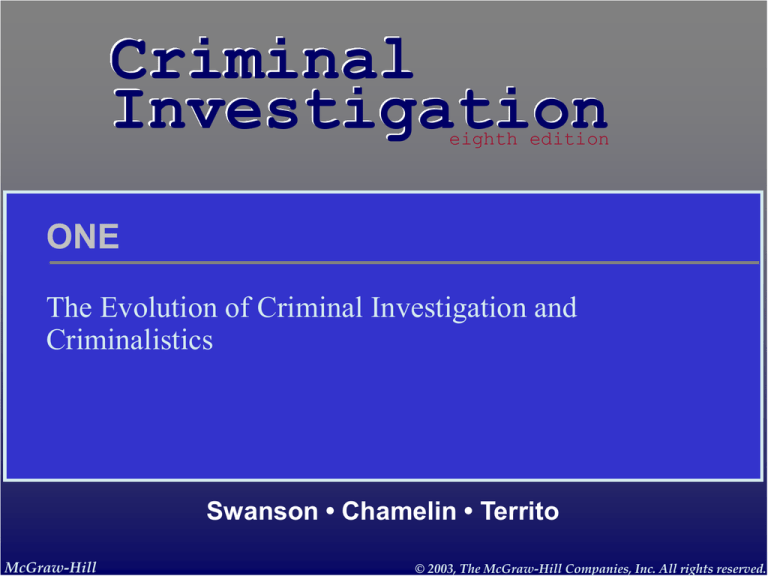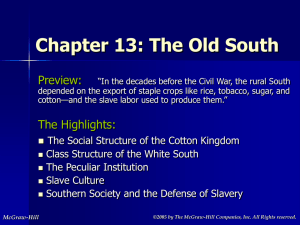
Criminal
Investigation
eighth edition
ONE
The Evolution of Criminal Investigation and
Criminalistics
Swanson • Chamelin • Territo
McGraw-Hill
© 2003, The McGraw-Hill Companies, Inc. All rights reserved.
LEARNING OBJECTIVES
• Explain the importance of the Bow Street Runners
• Discuss the contribution of Sir Robert Peel’s reform to
early policing in the United States
• Explain the history and function of the Pinkerton National
Detective Agency
• Highlight the first major federal investigative agencies
and their responsibilities
• Explain the impact of Supreme Court's "due process
revolution" and its impact on policing
• Discuss Bertillon’s method of anthropometry
• Summarize the historical development of fingerprint
identification
• Explain the concept and practice of DNA typing
• Outline the milestones in the development of firearms
identification
McGraw-Hill
1-1
© 2003, The McGraw-Hill Companies, Inc. All rights reserved.
THE BOW STREET RUNNERS
• Small group of volunteers/non-uniformed
homeowners
• Established in 1750 by Henry Fielding/called
"Take Thieves"
• Hurry to scene of crime and begin investigation
• First modern detective force
McGraw-Hill
1-2
© 2003, The McGraw-Hill Companies, Inc. All rights reserved.
SIR ROBERT PEEL
• His efforts led to the establishment of a
Metropolitan police force for London
• Peel is considered the father of modern policing
• Many of his reforms are part of policing today in
America
• Peel was considered a skillful administrator with
vision
McGraw-Hill
1-3
© 2003, The McGraw-Hill Companies, Inc. All rights reserved.
PEEL’S PRINCIPLES
1. The police must be stable, efficient, organized
along military lines.
2. The police must be under government control.
3. The absence of crime best proves efficiency of
police.
4. The distribution of crime news is essential.
5. The deployment of police strength over time
and area is essential.
6. No quality is more indispensable to a police
officer than a perfect command of temper.
McGraw-Hill
1-4(a)
© 2003, The McGraw-Hill Companies, Inc. All rights reserved.
PEEL’S PRINCIPLES (cont'd)
7. Good appearance commands respect.
8. Securing and training proper people is the root
of efficiency.
9. Public security demands every police officer be
given a number.
10. Police headquarters should be centrally
located/easily accessible.
11. Police should be hired on a probationary basis.
12. Police records are necessary to the correctly
distribute police strength.
McGraw-Hill
1-4(b)
© 2003, The McGraw-Hill Companies, Inc. All rights reserved.
DETECTIVES IN THE U.S. EVOLVED IN THE
PRIVATE SECTOR
• Graft/corruption common in big city police
departments
• Municipal police jurisdictions were limited.
• Little communication between police
departments in different cities.
• Offenders could flee from one jurisdiction to
another
• Private sector detectives like Pinkerton’s
developed
McGraw-Hill
1-5
© 2003, The McGraw-Hill Companies, Inc. All rights reserved.
PINKERTON AT WORK
• Protected Presidentelect Lincoln
• Operated an intelligence
service for the union
army
• Pursued bank and
railroad robbers
• Created extensive
criminal records
• Provided a good model
for government
detectives
(Courtesy Pinkerton’s Archives)
McGraw-Hill
1-6
© 2003, The McGraw-Hill Companies, Inc. All rights reserved.
EARLY FEDERAL INVESTIGATIVE AGENCIES
1865 Secret Service created to combat
counterfeiting
1903 After assassination of McKinley
responsibility for presidential protection was
added
1908 Bureau of Investigation became F.B.I.
1924/Hover
1920 Internal Revenue responsible for
Prohibition enforcement
McGraw-Hill
1-7
© 2003, The McGraw-Hill Companies, Inc. All rights reserved.
DUE PROCESS REVOLUTION
• Cases decided by the U.S. Supreme Court,
1961-1966
• Known as due process revolution
• Active in cases involving rights of
suspects/defendants
• Miranda, Mapp v. Ohio, Terry decisions impact
police
McGraw-Hill
1-8
© 2003, The McGraw-Hill Companies, Inc. All rights reserved.
NYPD ROGUES’ GALLERY
• N.Y.P.D. established
Rogues' Gallery in 1857
• Photographs of known
offenders were included
• Photos were arranged
by their criminal
specialty and height
• Used by detectives to
recognize criminals on
the street
(Courtesy Library of Congress)
McGraw-Hill
1-9
© 2003, The McGraw-Hill Companies, Inc. All rights reserved.
ANTHROPOMETRY
• First method of criminal identification thought to
be reliable; based on a criteria of body
measurements
• Developed by Bertillon (1853-1916)/father of
criminal identification
• After 1883 the system was adopted throughout
Europe
• System was abandoned because dactylography
(fingerprint identification) simpler, more reliable
McGraw-Hill
1-10
© 2003, The McGraw-Hill Companies, Inc. All rights reserved.
HENRY BERTILLON AND A BERTILLON MEASUREMENT
(Courtesy Library of Congress)
(Courtesy Jacques Ganthial)
McGraw-Hill
1-11
© 2003, The McGraw-Hill Companies, Inc. All rights reserved.
MILESTONES IN THE DEVELOPMENT OF
DACTYLOGRAPHY
1684 England’s Dr. Grew observes pores and
ridges in hands and feet
1823 Perkinje develops nine standard fingerprint
patterns and classification system
1892 Galton publishes “Fingerprints,” first
definitive book on dactylography
1894 Vucetich publishes “Dictiloscopia
Comparada”, outlining his system
McGraw-Hill
1-12(a) © 2003, The McGraw-Hill Companies, Inc. All rights reserved.
MILESTONES IN THE DEVELOPMENT
OF DACTYLOGRAPHY (Cont.)
1900 The Henry system was adopted in England
1901 Henry publishes “Classification and Use of
Fingerprints,” outlining his system of
fingerprint classification
1903 The Will West/William West case
demonstrates the superiority of
dactylography to anthropometry
McGraw-Hill
1-12(b) © 2003, The McGraw-Hill Companies, Inc. All rights reserved.
DNA
• Deoxyribonucleic Acid, chemical blueprint which
determines everything from our hair color to our
disease vulnerabilities; with the exception of
identical twins, each person has a unique DNA
makeup
• DNA is unique to individuals
• The human sources of DNA are: blood and
tissue; spermatozoa; bone marrow, tooth pulp
and hair root cells
McGraw-Hill
1-13
© 2003, The McGraw-Hill Companies, Inc. All rights reserved.
DNA TYPING
• DNA is a chemical blueprint
• The Enderby cases were the first use DNA
typing in England in 1987
• The Orlando cases were the first used in the
U.S. in1986
• The FBI crime lab was the first public lab to use
DNA analysis in 1988
McGraw-Hill
1-14
© 2003, The McGraw-Hill Companies, Inc. All rights reserved.
MILESTONES IN FIREARMS IDENTIFICATION
1835 Henry Goddard
First successful murderer identification from bullet
removed from victim’s body
1889 Professor Lacassagne identified grooves
on a removed bullet removed from a corpse
and matched it to a suspect’s weapon
1898 Jeserich took microphotographs of fatal
and test bullets
He testified the defendant’s revolver fired the fatal
bullet
1926 Calvin Goddard was most responsible for
raising firearm identification to a science
McGraw-Hill
1-15
© 2003, The McGraw-Hill Companies, Inc. All rights reserved.












